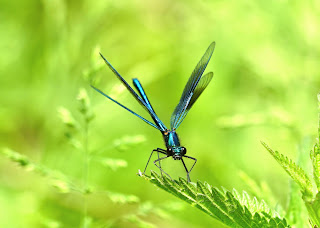On this glorious warm day I was at Cranford CP to complete the UKBMS butterfly transect across the park. I felt at the time that there were not that many butterflies on the wing, and as I have to follow a set route each transect I decided to compare todays numbers to the past few years.
I first started undertaking the UKBMS transect at Cranford CP in August 2016, so no records for June of that year, but below are the numbers for the nearest dates in 2017, 2018, 2019 and 2020 ....
11/06/2017
average temp: 21c
wind speed: low
sunshine: 100%
Large Skipper x 3
Green-veined White x 2
Red Admiral x 4
Small Tortoiseshell x 1
Comma x 2
Speckled Wood x 11
Meadow Brown x 10
Total 7 species
06/06/2018
average temp: 20c
wind speed: low-med
sunshine: 100%
Large Skipper x 2
Large White x 1
Small Copper x 1
Common Blue x 6
Holly Blue x 3
Red Admiral x 1
Comma x 2
Speckled Wood x 9
Meadow Brown x 7
Small Heath x 7
Total 10 species
29/05/2019
average temp: 21c
wind speed: med
sunshine: 90%
Green-veined White x 1
Orange-tip x 1
Common Blue x 5
Holly Blue x 1
Speckled Wood x 4
Total 5 species
13/06/2020
average temp: 21c
wind speed: low-med
sunshine: 100%
Small Skipper x 1
Large White x 7
Small White x 1
Comma x 8
Speckled Wood x 2
Meadow Brown x 11
Small Heath x 5
Total 7 species
03/06/2021
average temp: 21c
wind speed: low
sunshine: 80%
Brimstone x 1
Large White x 1
Brown Argus x 1
Holly Blue x 1
Red Admiral x 1
Speckled Wood x 4
Small Heath x 1
Total 7 species
So today was pretty average in terms of species seen, but numbers are fairly low compared to previous years. I can only hazard a guess that this years mild March, cold April and wet May have not been good for our butterflies. Hopefully numbers will bounce back as the season goes on.
 |
| Brimstone |
 |
| Red Admiral |
I always finish my transect at the stone bridge and walk up to the wildlife pond to tally up my figures. Whilst sitting there today I noticed very good numbers of one of the earliest damselflies to emerge, the dainty Large Red, and couldn't resist taking loads of photos from my great vantage point (the tree stump by the end of the pond)
But my 'sight of the day' were the sheer numbers of the characteristic Banded Demoiselles. Both males and females were in great numbers not only along the River Crane but also in the nettle patches, and along the row of immature oaks that run along side the grass paths from the cattle paddock down to the iron bridge. The males were so intent on displaying to the females that I was often able to get quite close for some of my photos.
According to one of my favourite ID books 'Britain's Dragonflies' by Dave Smallshire and Andy Swash, the 'males are territorial but large numbers can be found among lush bankside herbage and on floating plants. They court females by flicking their wings open and performing an aerial dance in front of them. Like many damselflies, females stay away from water unless looking for a mate or egg-laying. The adults make use of luxuriant vegetation like nettle beds and tall emergent grasses'
They really have to my favourite of all the dragonflies. The colours are so intense and bright that in Ireland they are often known as the Banded Jewelwing, and that name could not be more fitting. Be prepared for a complete photo overload of these stunning little damsels.....
 |
| male |
 |
| female |
Whilst sitting by the wildlife pond I noticed a lot of the resident Honeybees were taking advantage of the submerged log, to have a safe drink ...
A very fitting end to a very pleasant day.



















No comments:
Post a Comment